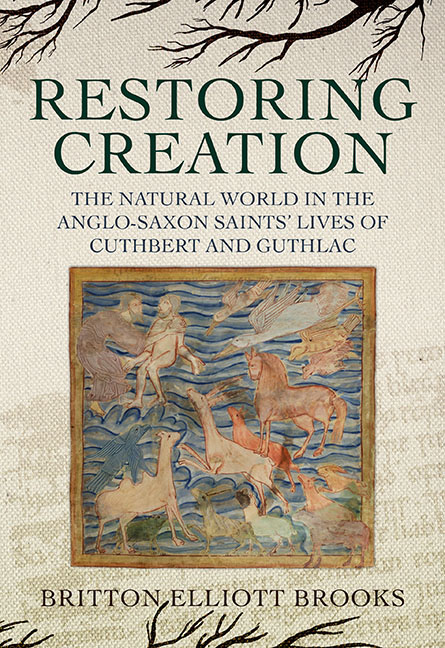 Restoring Creation: The Natural World in the Anglo-Saxon Saints' Lives of Cuthbert and Guthlac
Restoring Creation: The Natural World in the Anglo-Saxon Saints' Lives of Cuthbert and Guthlac Book contents
- Frontmatter
- Contents
- Acknowledgements
- Abbreviations
- Introduction
- 1 Monastic Obedience and Prelapsarian Cosmography: The Anonymous Vita Sancti Cuthberti
- 2 Ruminative Poetry and the Divine Office: Bede's Metrical Vita Sancti Cuthberti
- 3 Bede's Exegesis and Developmental Sanctity: The Prose Vita Sancti Cuthberti
- 4 Enargaeic Landscapes and Spiritual Progression: Felix's Vita Sancti Guthlaci
- 5 Landscape Lexis and Creation Restored: The Old English Prose Life of Guthlac and Guthlac A
- Conclusion: Afterlives of Cuthbert and Guthlac
- Bibliography
- Index
Introduction
Published online by Cambridge University Press: 18 September 2019
- Frontmatter
- Contents
- Acknowledgements
- Abbreviations
- Introduction
- 1 Monastic Obedience and Prelapsarian Cosmography: The Anonymous Vita Sancti Cuthberti
- 2 Ruminative Poetry and the Divine Office: Bede's Metrical Vita Sancti Cuthberti
- 3 Bede's Exegesis and Developmental Sanctity: The Prose Vita Sancti Cuthberti
- 4 Enargaeic Landscapes and Spiritual Progression: Felix's Vita Sancti Guthlaci
- 5 Landscape Lexis and Creation Restored: The Old English Prose Life of Guthlac and Guthlac A
- Conclusion: Afterlives of Cuthbert and Guthlac
- Bibliography
- Index
Summary
EVERY HOUR CHIMES with a new example of ecological crisis: the warming oceans, the loss of biodiversity, and the rise of anti-environmental public policies. In response to our contemporary moment, the Humanities have begun to engage in earnest with questions of ecology. This present study seeks to bring medieval literature into dialogue with these issues, analysing medieval constructions and interpretations of the non-human world as expressed in literature, by considering them in their historical context. This approach highlights how medieval peoples actively reflected upon their own engagement with the non-human world, structured in great part by their theology and philosophy, and articulated them through the artistry of their literature.
Restoring Creation: the Natural World in the Anglo-Saxon Saints’ Lives of Cuthbert and Guthlac engages with the growing interest throughout medieval scholarship in the environmental humanities, evidenced by the number of monographs published in the past few years on such topics, including Water in Medieval Literature by Albrecht Classen; Anglo-Saxon Literary Landscapes: Ecotheory and the Environmental Imagination, by Heidi Estes; and Inhabited Spaces: Anglo-Saxon Constructions of Place, by Nicole G. Discenza. This engagement by medieval scholars is heartening, as the majority of the studies in the environmental humanities, in Estes's words, ‘dismiss or ignore the medieval, or misrepresent it in discussions of the modern’. This is most evident in the wider, and erroneous, conceptions of the negative role of the natural world in medieval literature, particularly in relation to ecocritical scholarship. For example, Timothy Morton, one of the leading ecocritical theorists, describes the natural world in medieval texts in negative and dismissive terms: ‘Nature, practically a synonym for evil in the Middle Ages, was considered the basis of social good by the Romantic Period.’ This oversimplification of medieval literature is unfortunate, to say the least, and fundamentally distorting, both for the project of literary analysis as a whole, and also for broader discussions in the environmental humanities. The negative vision of the relationship between medieval people and the natural world also appears in more popular arenas, as evidenced by the scholar and writer Alexandra Harris.
- Type
- Chapter
- Information
- Restoring Creation: The Natural World in the Anglo-Saxon Saints' Lives of Cuthbert and GuthlacThe Natural World in the Anglo-Saxon Saints’ Lives of Cuthbert and Guthlac, pp. 1 - 18Publisher: Boydell & BrewerPrint publication year: 2019
